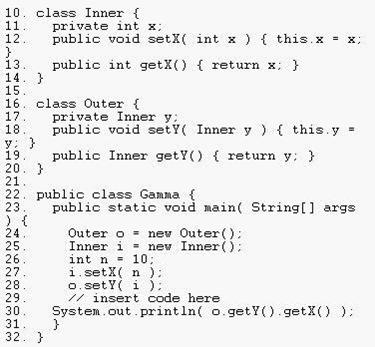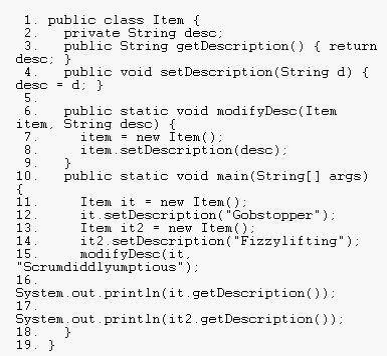Page: 4
8. OOPs
Q: 16 Click the Exhibit button. Which three code fragments, added individually at line 29, produce the output 100? (Choose three.) 
A. n = 100;
B. i.setX( 100 );
C. o.getY().setX( 100 );
D. i = new Inner(); i.setX( 100 );
E. o.setY( i ); i = new Inner(); i.setX( 100 );
F. i = new Inner(); i.setX( 100 ); o.setY( i ); Answer: B, C, F Q: 17 Given:
10. class One {
11. public One() { System.out.print(1); }
12. }
13. class Two extends One {
14. public Two() { System.out.print(2); }
15. }
16. class Three extends Two {
17. public Three() { System.out.print(3); }
18. }
19. public class Numbers{
20. public static void main( String[] argv ) { new Three(); }
21. }
What is the result when this code is executed?
A. 1
B. 3
C. 123
D. 321
E. The code runs with no output. Answer: C Q: 18 Click the Exhibit button.
What is the outcome of the code? 
A. Compilation fails.
B. Gobstopper
Fizzylifting
C. Gobstopper
Scrumdiddlyumptious
D. Scrumdiddlyumptious
Fizzylifting
E. Scrumdiddlyumptious
Answer: B Q: 19 Given: 10. class One {
11. public One foo() { return this; }
12. }
13. class Two extends One {
14. public One foo() { return this; }
15. }
16. class Three extends Two {
17. // insert method here
18. }
Which two methods, inserted individually, correctly complete the Three class? (Choose two.)
A. public void foo() {}
B. public int foo() { return 3; }
C. public Two foo() { return this; }
D. public One foo() { return this; }
E. public Object foo() { return this; } Answer: C, D
Page: 4
1
2
3
4
5
6
7
8
9
10
11
12
13
14
15
16
17
|